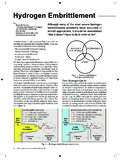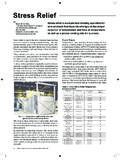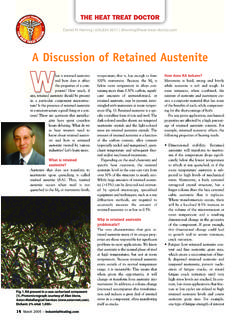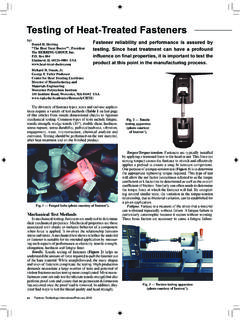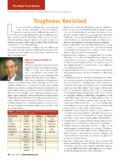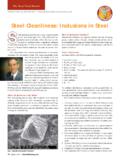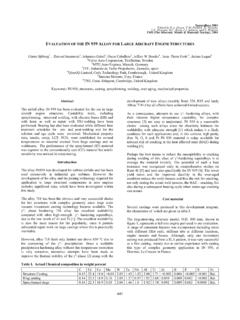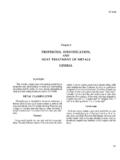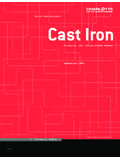Transcription of Heat Treatment of Cast Irons - Heat Treat Doctor.com
1 Ron is the fourth most abundant ele-ment on Earth and is one of the mostwidely disbursed elements in theEarth's crust. In nature it is found invarious compounds with oxygen, sulfur, ormore complicated ores such as carbonatesand silicates (Table 1). Because iron is soabundant, combines readily with other ele-ments (such as manganese to form steel)and requires relatively little energy toextract it from ore, it is one of the mostattractive elements to use for the productswe require in everyday life (Fig. 1). cast IronsCast iron is a generic term used to designatea family of metals with a wide variety ofproperties. All cast Irons contain more than2% carbon and an appreciable amount ofsilicon (usually 1-3%). The high carbonand silicon content means that they areeasily melted, have good fluidity in the liq-uid state and have excellent pouring prop-erties.
2 The basic types of cast iron are bestdifferentiated by their microstructure asopposed to their chemical analysis becausethe various types overlap (Table 2).The metallurgy of cast iron is more com-plex than its economics and, in fact, is oneof the more complex metallurgical systems[Fig 2]. iron -carbon alloys with less than2% carbon are metastable; the true stablesystem being iron -graphite (Fe-C). Thegeneral term cast iron includes pig iron ,gray iron , malleable iron , chilled iron ,white iron , and nodular or ductile an iron alloy exceeds about 2% car-bon, the carbon does not have to nucleatefrom decomposition of austenite, butinstead, it can form directly from the meltby a eutectic reaction. Note that cementite(Fe3C) can still nucleate at the eutecticmore readily than graphite, but on suffi-ciently slow cooling, graphite itself is ableto form and the solidification of a 3% car-bon cast iron (Fig.)
3 3). At a rapid coolingrate, dendrites of austenite form as thealloy cools below the liquidus and growuntil the eutectic temperature is the eutectic, graphite formation is sup-pressed, but austenite and cementite pre-cipitate to form ledeburite, a form ofeutectic that consists of spheres of austen-ite embedded in cementite. Ledeburiteforms at the Fe-Fe3C eutectic (solid line nm ). On further cooling, the cementitegrows as the austenite decreases in carboncontent (along the solid line no ) At theeutectic (point o ), the remainingaustenite transforms to pearlite. At roomtemperature, the iron is hard and brittleand is called white iron because the sur-face of a fractured piece of iron is whiteand (somewhat) slow cooling of a 3% carbon castiron, austenite forms from the melt, buteutectic freezing is now slow enough so theproducts of the eutectic reaction December 2004 23 THERMAL PROCESSINGIron (Fe), derives it name from the Latin word ferrum.
4 In its pureform iron is lustrous, silvery, soft, and ductile. However, pure iron is a poor engineering material, generally not as strong as most plastics. cast Irons are based on the Fe-C system, and the solid-statetransformations on which cast iron heat treatments are based aresimilar to those applied to Treatment of cast IronsDaniel H. Herring, The HERRING GROUP, Inc., Elmhurst, priceRelative productionLeadZincCalciumMercurySelenium VanadiumTungstenTable 1 Common iron Ores [1]Mineralogical nameChemical formulaChemical Fe, Fe, Fe, O2, TiOxideLimoniteHFeO2 FeO(OH) Fe, O2, Fe, SSulfi Fe, CO2, O2 CarbonateFig 1 (right). Cost of materials versus their relative use [2]austenite and graphite (the reaction takesplace at the dotted line nm ). The eutec-tic graphite tends to form flakes surround-ed by eutectic austenite.
5 As cooling con-tinues, the austenite decreases in carboncontent (along the dotted line no ),while the remaining austentite transformsto pearlite. Because the fracture surfaceappears dull gray the material is known asgray iron (or pearlitic gray iron ).Cooling at an extremely slow rate resultsin phase changes similar to those of a slowcooled component, except the eutectoidcooling is sufficiently slow to permitgraphite to precipitate rather than new graphite flakes will form, but theones present will increase in size. The finalmicrostructure consists of graphite flakesembedded in a ferrite matrix. The resultantmaterial is called ferritic gray iron (coolingof actual castings cooling is seldom slowenough to obtain this structure).The cooling rate of a portion of a castingsometimes may vary, resulting in a struc-ture containing patches of both white andgray iron , called mottled iron [4].
6 Graphite forms in cast iron in severaldifferent shapes including flakes, nodulesand spheroids (Fig. 4). Because graphitehas very little (cohesive) strength andreduces the effective metallic cross sectionof the casting, both strength and ductilityare affected. Types of ironPig iron is the term that is generallyapplied to a metallic product that containsover 90% iron . Typically it containsapproximately 3% carbon, siliconand lesser amounts of manganese, sulfurand phosphorus. Pig iron along with scarpmetal is the base material for both cast ironand cast Irons are alloys of iron , carbon andsilicon, in which more carbon is presentthan can be retained in solid solution inaustenite at the eutectic temperature. Thecarbon precipitates as graphite flakes.
7 Thegray Irons typically contain from carbon and 1% - 3% silicon as most common heat treatmentsapplied to gray cast Irons arestress relief because ofnonuniform cooling of cast -ings and annealing toimprove heating is used for both. Stressrelief is done at temperatures between 1020and 1200 F (550 and 650 C) without sig-nificantly lowering strength and at temperatures between 1290 and1400 F (700 and 760 C) lowers the hard-ness for improved iron , also known as ductile ironor spheroidal graphite iron , is cast iron inwhich the graphite is present as tiny balls,or spherulites, instead of graphite flakes (asin gray iron ), or compacted aggregates (asin malleable iron ). The nodular Irons typi-cally contain from C, Siand up to Mn as major types of matrix structures (includ-ing ferritic and pearlitic) can be developedby alloying and heat Treatment .
8 The vari-ous grades of regular, unalloyed ductile ironare designated by their tensile properties(Table 3). heat Treatment of ductile cast ironincludes stress relief and annealing, as wellas heat treatments used for steels includingnormalize and temper (for higher strengthand wear-resistance), quench and temper(for the highest strength), and austemper-ing. Ferritizing (for the most ductilemicrostructure) is done by austenitizing at1650 F (900 C), followed by holding at1290 F (700 C) to completely transform24 December 2004 PROCESSINGT able 2 Typical Composition of Unalloyed cast Irons [3]ElementGray iron , %Malleable iron , %White iron , %Nodular iron , % maxTable 3 Common Grades of Ductile iron [3]Type (TS-YS-%EL)Tensile strength, ksiYield strength, ksiElong.
9 , %Hardness, BHNHeat treatmentTypical micro-structure60-40-18604018137-170 AnnealedAll ferrite65-45-12654512149-229-Ferritic80- 55-0685556179-255-Ferrite & pearlite100-70-03100703229-302 Normal-izedAll pearlite120-90-02120902250-350 Quench & TemperedTempered martensite260024002200200018001600140012 00150014001300120011001000900800700600 Temperature, FTemperature, content, wt%Delta ferriteMeltAustenite + meltAustenite + carbideAusteniteAustenite + FerriteFerriteFerrite + carbideA1A3 AcmFerrite +austenite+carbideMelt +carbideFig 2. Fe-C-Si diagram at 2% strongly promotes graphite December 2004 25austenite to ferrite and Irons are relatively soft andcan be bent without breaking. Theyinclude ferritic (or standard) malleableiron and pearlitic malleable iron is obtained by the heattreatment of white iron so the hard ironcarbide structure of ledeburite is convertedto a matrix of ferrite or pearlite andgraphite is precipitated within the form of graphite is sometimes referredto as tempered carbon.
10 A wide range ofmechanical properties can be obtained inmalleable iron with different matrix struc-tures around the malleable iron has a ferritematrix with interspersed nodules of tem-pered carbon and, depending on how it isproduced, some combined carbon. Pearliticmalleable iron is designed to have combinedcarbon in the matrix, resulting in higherstrength and hardness than ferritic mal-leable iron . The malleable Irons typicallycontain from C, Siand Mn as major cast iron can be heat treatedto the same microstructures as ductilecast cast iron is produced by castingthe molten metal in such a way as to pro-duce a surface virtually free of graphiticTHERMAL PROCESSINGA usteniteandliquidAusteniteandledeburiteP earlite andtransformedledeburiteAusteniteandliqu idAusteniteandgraphitePearliteandgraphit eSlowly cooledFig 3.

